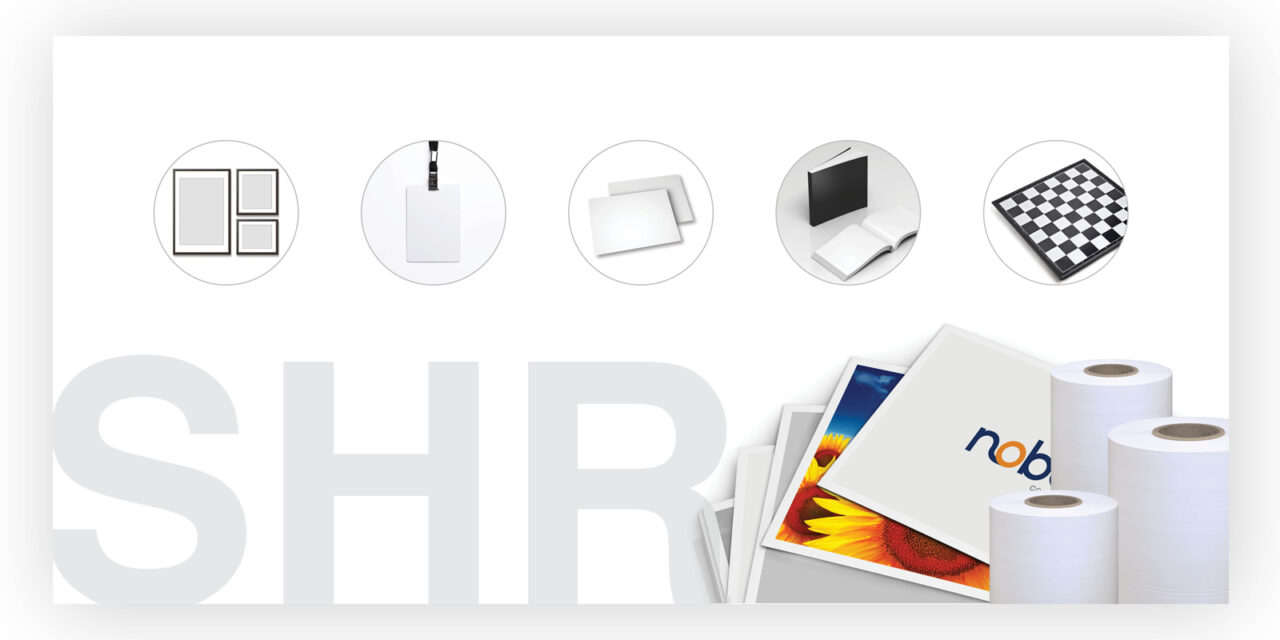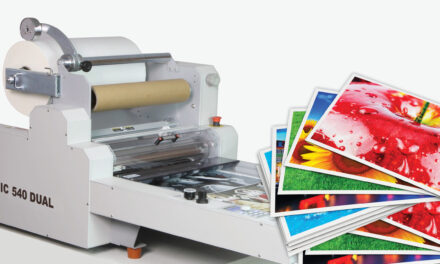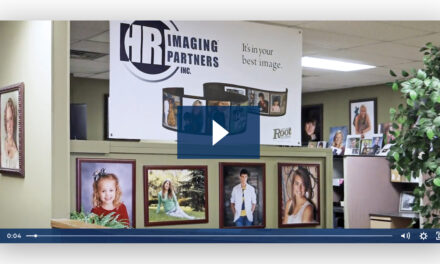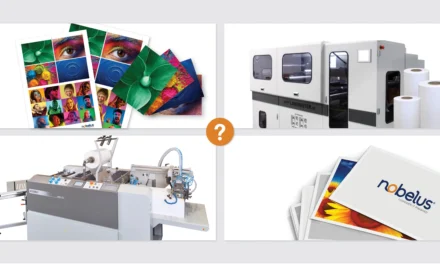MARKET EXPANSION WITH SHR™
As conventional silver halide photo printing becomes increasingly more challenging due to concerns surrounding the economy, environment, and global supply chains, many in the photofinishing industry are turning to digital processes for their photos and portraits. However, most photo printers who make the swap to digital technology are unaware that modern print finishing equipment can produce more than beautiful photographs.
To truly make the most of the initial investment that comes with moving away from silver halide to SHR, it is crucial that photo printers understand the capabilities of the thermal laminating systems they have purchased. This article will look at some diverse uses for thermal laminators designed for digital photo production and examine how photofinishing businesses can branch out into unexpected niches to help grow their business and carve out a unique spot in the industry for their operation.
What Is SHR?
Short for “silver halide replacement,” SHR refers to the process of swapping over from silver halide production to digital printing. Photo printers first upload the images to be printed onto the software of a digital press and then allow the press to automatically print the photos on the paper of their choice. After the photos are printed, they are transferred over to a thermal laminating system to receive the specially designed PlatinumSHR™ 1.6 mil Gloss Laminate.
This laminate comes with a gloss finish, but its surface is highly embossable; once the laminate is embossed, it takes on a luster that is distinctly identical to that of a conventional silver halide “luster” photo. To provide total protection to the photo and give it the emulsion feel of a traditional photograph, PlatinumOPP™ 1.0 mil Matte Laminate can be used on the back of the substrate to give it additional weight and thickness.
For a more in-depth explanation of SHR, read through our article “Silver Halide Replacement: The Future of Photofinishing.”
What Equipment Is Needed for SHR?
While we have covered this question in great detail in our post “What Equipment Do I Need for SHR?”, the process can be summarized with the following steps:
- Printing
- Lamination
- Cutting
- Sorting
Depending on the application, printers may not need to purchase equipment for each step. For the purposes of this topic, we will be focusing primarily on the capabilities of digital presses and thermal lamination systems.
Digital presses come in many different designs from a variety of manufacturers, and each type of system might be best for a specific photo printer depending on their need state. The most important distinction between presses for most photo printers will lie in the type of ink used. We recommend contacting the press manufacturer to gain additional insight into the benefits and limitations of the ink used for their presses. While most inks are suitable for a wide range of products, they may be able to offer guidance regarding compatibility and quality.
Thermal lamination can support all different types of photofinishing businesses as they are available in both sheet-fed and roll-to-roll options. When choosing a thermal laminating system for digital photos, photo labs should always make sure they purchase a unit that includes the appropriate embossing roller. This roller is the component that gives the photo its luster finish, and laminators without this crucial part cannot accurately recreate the look of a conventional photo. Able to support many different applications beyond photographs, laminators with an embossing roller can process a variety of different substrates and film types. Many manufacturers offer other patterns for their embossing rollers, such as leather and linen.
USING SHR FOR OTHER APPLICATIONS
Given the flexibility of most digital presses and laminators, it should come as no surprise that photo labs that switch to SHR instantly open a path to a huge variety of applications beyond photos. Some may be closely related to photos and appeal to the same customer base, but many of these applications are totally distinct from photos and promise true market growth for photo printers.
Photo-Based Applications
The most natural route for photo printers to take is utilizing their digital photos in different ways for creative physical products. Some of these applications may serve as a way to upsell existing customers or increase the photo business’s value to specific demographics, while others will allow the printer to draw in an entirely new customer base.
Fun packs
Fun packs are popular with parents of school-age children as they are most often mailed out alongside packets of standard school photos. These packs include several variations on photos, ranging from bookmarks and fridge magnets to ornaments, door hangers, and decorative tags for backpacks. Several copies of the same photo are spaced out strategically on a single sheet, leaving room for different shapes to be cut out with perforation. Oftentimes, the sheets used have colorful patterns that result in a bright, fun keepsake when the shape is popped out. Some laminates even have a writable surface that allows the student to write his or her name on the piece.
Fun packs do require an additional investment in the form of a laser cutting or rotary die cutting machine that can be programmed to produce different shapes on demand. However, these designs can be changed year over year, leading to a greater chance that parents or students will continue purchasing the packs as the student moves up in grade.
Identification Cards
Corporate offices, schools and colleges, clubs and organizations – it can be easy to overlook just how often photo identification can play a role in everyday life for the average person, even beyond government-issued IDs like driver’s licenses and passport cards. Offering identification cards can be a simple, effective way to reel in new customers while still focusing on photos. One key difference between IDs and many other types of prints is that identification cards typically require an added level of protection and rigidity. This means that printers will need to stock thicker laminates made of polyester (PET) and ensure their laminating machine can properly process and cut the film.
Holiday Cards and Postcards
It is becoming more common for couples and families to use their own photos on cards for major holidays. The ability to go online, upload a favorite photograph, and type out an annual family update has led to a resurgence in the popularity of these cards, making them a natural next step for any photo printing operation that has begun using SHR.
Photo labs can even offer unique finishes besides the classic photo luster by purchasing tactile laminates. These laminates can include soft-touch, linen, and even leather textures. In a similar vein, customers might want to include a personal photo they have taken on their travels on a postcard. To further enhance the value of these cards, printers can offer customers a durable scuff-resistant laminate or rough-touch option that will remain scratch free even after traveling through the mail.
Photo Books and Calendars
While many still prefer to assemble a photo album by hand, digital technology now allows people to upload entire reels of digitized photos to online software and select how they want them ordered and laid out. By providing these customers with a fully assembled photo book that is carefully bound without any loose photos that could fall out, photo printers can greatly increase the value of their services. Certain book designs can even be created to cater to common major life events, such as weddings, birthdays, family reunions, and more. Photo labs can utilize nylon laminates to create “lay-flat” books that offer greater protection for each page and ensure the book lies flat when opened on a table.
Many mass-produced calendars include images of landscapes, architecture, and animals for each month of the year to brighten up a wall or desk space. However, photo printers who use thermal lamination can begin offering calendars to their customers as a fun way to keep their photos in a highly visible space. Whether the calendar is used to display family memories from the year before or acts as a conversation piece for their photography hobby, many people enjoy having a functional use for their photographs. Lamination helps ensure pages in the calendar do not get accidentally torn out when the next month is flipped.
Both applications will require binding equipment and related supplies, but the return on investment can be significant with the right promotional efforts and awareness. Perhaps more than any other application, these prints require a high level of customer service to ensure the end user is happy with how the photos are oriented.
Other Applications
Photograph applications are not the only option for printers who use SHR. Many businesses utilize photos for their marketing efforts, and there are niche applications that may be overlooked by larger print and packaging businesses. A shrewd digital photo printer can use their digital press and thermal laminator to partner with large businesses and organizations to great benefit.
Book Covers
Although many publishing houses have in-house designers to create artistic graphics for their books, many publishers still utilize photography in their book covers. Additionally, self-publishing has become much more popular in recent years as companies like Amazon encourage new writers to turn their work into a physical book to share. Whether the author wants to make their story available for purchase online or simply wants to gift their loved ones a copy, a photo printer with a digital press and laminator can print high-quality book covers on-demand.
Game Boards and Cards
Similarly to self-publishing authors, a growing number of amateur board game and card game designers are seeking out printers to help their abstract game concepts turn into a playable tabletop product. Printers can once again offer both tactile and damage-proof laminates to ensure these pieces last for years while looking and feeling amazing. Game boards, cards, tokens, character cards, and many other game components can be greatly elevated simply by adding a specialty laminate finish. Tactile finishes are especially popular in this space as most board game enthusiasts appreciate it when the game pieces they handle on a regular basis have a pleasant haptic appeal.
Diplomas and Certificates
While it is rare for diplomas or certificates to have anything beyond the most basic text as imagery, photo printers who work closely with schools and universities may be able to tie in these sorts of applications with a school photo package, allowing schools to deal with a single business instead of sourcing their photos and certificates from different places. Depending on the type of certificate, an elegant pattern or finish like our FineLinen™ Laminate can serve as a perfect way to add an interesting texture element to the framed piece.
Artwork
Fabric and textile-based wall art can be expensive when decorating a larger space, such as an office building. SHR printers can offer customers a more economical option by giving standard paper or plastic substrates a fabric appeal when fitted over a frame. Like with many other applications listed above, artwork can serve as an excellent upsell when dealing with a customer with office space in need of decoration.
READY TO EXPLORE SHR?
Contact our team today to discuss the SHR process and discover how your printing business can make the most use of your embossing thermal laminator. We offer free samples of all the laminate products outlined above so you can experiment with different applications and markets at no risk. As a leading print finishing solutions provider, our team has developed close working relationships with many press and finishing equipment manufacturers. Let us walk alongside you and connect you with the right manufacturers to ensure your continued growth in a competitive market.





